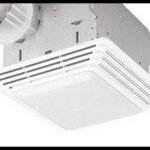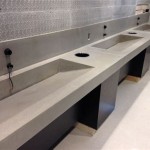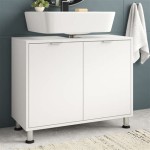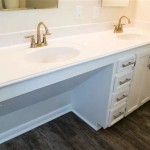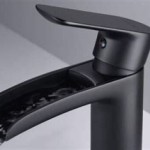Recessed Lighting for Small Bathrooms: Optimizing Space and Illumination
Recessed lighting, also known as can lighting, is a popular choice for illuminating various spaces, particularly small bathrooms. Its flush-mounted design offers a clean, streamlined aesthetic while maximizing headroom and minimizing visual clutter. In a confined bathroom, where space is at a premium, recessed lighting can significantly enhance functionality and create a more open and inviting atmosphere. This article will explore the key considerations for implementing recessed lighting in a small bathroom, covering fixture selection, placement, electrical safety, and energy efficiency.
Choosing the Right Recessed Lighting Fixtures
Selecting appropriate recessed lighting fixtures is paramount to achieving optimal illumination in a small bathroom. Several factors influence this decision, including fixture size, type, and trim. The size of the fixture, typically measured in diameter, should be proportional to the bathroom’s overall dimensions. Smaller bathrooms generally benefit from smaller fixtures, such as 4-inch or 5-inch cans, to avoid overpowering the space. Larger cans may be suitable for slightly larger bathrooms, but careful consideration of spacing is still crucial.
The type of recessed lighting fixture dictates its intended application and light output. Common types include incandescent, halogen, LED, and compact fluorescent (CFL) fixtures. Incandescent and halogen lamps are less energy-efficient and produce more heat compared to LED and CFL options. LEDs are highly recommended for bathroom lighting due to their long lifespan, low energy consumption, and cool operating temperature. They also offer a wide range of color temperatures, allowing for customized lighting effects.
The trim of a recessed lighting fixture refers to the visible portion that surrounds the light bulb. Trims are available in various shapes, styles, and finishes, influencing the direction and quality of light. Baffle trims feature a series of concentric rings that reduce glare and soften the light, making them suitable for general illumination. Reflector trims, typically smooth and angled, direct light downwards, creating a brighter, more focused beam. Eyeball trims are adjustable and allow for directional lighting, which can be beneficial for highlighting specific areas, such as artwork or vanity mirrors. For bathrooms with showers or tubs, wet-rated trims are essential to protect the fixture from moisture and ensure safety.
Strategic Placement of Recessed Lighting
Strategic placement of recessed lighting fixtures is essential for achieving balanced and effective illumination in a small bathroom. A poorly planned layout can result in uneven lighting, shadows, and visual discomfort. Several key areas require careful consideration when planning recessed lighting in a bathroom.
General ambient lighting provides overall illumination for the entire bathroom. This can be achieved by evenly spacing recessed lights across the ceiling. The number of fixtures required depends on the bathroom’s size and the light output of each fixture. A general rule of thumb is to space fixtures approximately 2 to 4 feet apart, ensuring consistent light distribution. Dimmers are highly recommended for ambient lighting, allowing for adjustable brightness levels to suit different tasks and moods.
Task lighting focuses on illuminating specific areas where tasks are performed, such as the vanity mirror for grooming and the shower or tub for bathing. Recessed lights positioned directly above the vanity mirror can create harsh shadows, making it difficult to see clearly. Instead, consider flanking the mirror with recessed lights placed on either side, providing even and flattering illumination. For the shower or tub area, wet-rated recessed lights should be positioned slightly outside the direct stream of water to prevent damage and ensure safety. A dedicated recessed light above the shower or tub provides adequate illumination for safe and comfortable bathing.
Accent lighting highlights specific features or architectural details in the bathroom, adding visual interest and depth. This can be achieved by strategically placing recessed lights to spotlight artwork, textured walls, or decorative niches. Eyeball trims are particularly well-suited for accent lighting, allowing for precise directional control. Dimmer switches can also be used to control the intensity of accent lighting, creating a more dramatic or subtle effect. Proper planning and consideration of the bathroom’s layout and design are crucial for effective accent lighting.
Electrical Safety and Codes
Electrical safety is of paramount importance when installing recessed lighting in a bathroom, particularly due to the presence of water. Adherence to local electrical codes and regulations is mandatory to prevent electrical shock and ensure the safety of occupants. Several key considerations must be addressed during the installation process.
All electrical work should be performed by a qualified and licensed electrician. Attempting to install recessed lighting without proper training and experience can be extremely dangerous and may violate local building codes. A licensed electrician possesses the necessary knowledge and skills to safely and correctly install electrical wiring, fixtures, and components. They will also ensure that all work is compliant with local electrical codes and regulations. They can also often obtain permits which are crucial to ensuring the safety of the install.
Ground Fault Circuit Interrupters (GFCIs) are essential for bathroom circuits, protecting against electrical shock by quickly shutting off power in the event of a ground fault. GFCIs should be installed on all circuits that serve outlets, lighting fixtures, and appliances in the bathroom. Regular testing of GFCIs is recommended to ensure they are functioning properly. Most modern breakers contain a GFCI already, but older electrical panels may require upgrading.
Wet-rated recessed lighting fixtures are specifically designed for use in damp or wet environments, such as showers and tubs. These fixtures are sealed to prevent moisture from entering and causing electrical hazards. Using non-wet-rated fixtures in these areas can be extremely dangerous and is strictly prohibited by most electrical codes. Ensure that all recessed lighting fixtures installed in the shower or tub area are clearly labeled as wet-rated.
Energy Efficiency and Cost Considerations
Energy efficiency is an important consideration when selecting and installing recessed lighting in a small bathroom. Choosing energy-efficient fixtures and implementing smart lighting controls can significantly reduce energy consumption and lower utility bills. Several strategies can be employed to maximize energy efficiency.
LED recessed lighting fixtures are significantly more energy-efficient than incandescent and halogen alternatives. LEDs consume up to 80% less energy and have a much longer lifespan, reducing the need for frequent bulb replacements. While the initial cost of LED fixtures may be higher, the long-term savings in energy and maintenance costs make them a worthwhile investment. Look for Energy Star certified LED fixtures, which meet strict energy efficiency standards.
Dimmers allow for adjustable brightness levels, reducing energy consumption when full brightness is not required. Dimmers can also extend the lifespan of light bulbs by reducing their operating temperature. Consider installing dimmer switches for ambient and accent lighting, allowing for customized lighting effects and energy savings. LED-compatible dimmers are essential for use with LED fixtures to ensure proper functionality and prevent flickering.
Occupancy sensors automatically turn lights on when someone enters the bathroom and off when they leave, eliminating the need to manually switch lights. This can be particularly beneficial in bathrooms that are not frequently used, such as guest bathrooms. Occupancy sensors can significantly reduce energy waste and lower utility bills. Adjustable time delay settings allow for customization of the sensor’s sensitivity and duration of illumination.

Bathroom Recessed Lighting Tips 1stoplighting

Things To Know About Bathroom Recessed Lighting Design Options Darbylanefurniture Com Light Fixtures Ceiling

New Recessed Lighting Dots Dashes Lightology Bathroom Ceiling Light

Bathroom Recessed Lighting Design Photos And Ideas Dwell

6 Design Ideas For Your Small Bathroom Supply Services Property Maintenance North Yorkshire

9 Bathroom Lighting Ideas You Ll Want To Install Right Now

Small Bathroom Lighting Ideas Sconce Vanity Recessed Fixtures Shower

Commercial Electric 6 In Selectable New Construction And Remodel Color Ultra Directional Canless Recessed Integrated Led Kit 91920 The Home Depot

Recessed Lighting In A Bathroom Modern Light Fixtures

Bathroom Recessed Lighting Design Photos And Ideas Dwell
Related Posts
